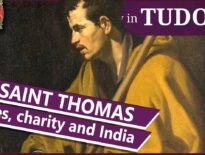On this day in Tudor history, 22nd December 1557, Protestant martyrs John Rough and Margaret Mearing, were burnt at Smithfield for heresy.
John Rough was a Scot who'd encouraged John Knox to be a pastor, but ended in days in England. Interestingly, the woman he died with was a woman he'd excommunicated from his congregation, believing her to be a spy. Although she'd been angry with her treatment, she was not the spy who betrayed him, she visited Rough in prison and was arrested after she tried to confront the real spy.
Find out about John Rough's life and what brought him to England, how he'd come to be arrested, and what happened with Margaret Mearing, in today's talk.
John Foxe's account can be read at https://www.dhi.ac.uk/foxe/index.php?realm=text&gototype=modern&edition=1583&pageid=2052
Also on this day in Tudor history, 22nd December 1534, John Fisher, Bishop of Rochester, who was a prisoner in the Tower of London, wrote to Thomas Cromwell.
In his letter to Cromwell, the poor bishop begged him for a shirt, sheet, food and books, as well as asking him to intercede with King Henry VIII on his behalf. It is so sad that a man who had served the king so loyally in the past had come to this, and, of course, the king's mercy would only stretch to commuting his method of execution to beheading.
Find out more in last year’s video:
Also on this day in history:
- 1480 – Baptism of Sir Edward Chamberlayne, soldier, a leading member of Oxfordshire gentry and Commissioner of the Peace for Oxfordshire (1506-1539) at Weston in Northamptonshire.
- 1541 - Members of the Howard and Tilney family, plus their staff, were tried for misprision of treason for covering up the “unlawful, carnal, voluptuous, and licentious life” of Queen Catherine Howard while she lived with the Dowager Duchess of Norfolk at Lambeth.
- 1545 – Birth of George Bannatyne, compiler of the “Bannatyne Manuscript”, at Edinburgh. The “Bannatyne Manuscript” is an anthology of Scots literature and included poems by Bannatyne, Alexander Montgomerie, Alexander Scott, David Lyndsay, William Dunbar, Robert Henryson and King James I.
- 1558 (22nd or 28th) – Death of John Christopherson, Bishop of Chichester. He was buried at Christchurch, Newgate Street. He had been put under house arrest following his definition of Protestantism as “a new invention of new men and heresies” on 27th November 1558, preached in response to a sermon at Paul's Cross.
Transcript:
On this day in Tudor history, 22nd December 1557, Protestant martyrs John Rough and Margaret Mearing, were burnt at Smithfield for heresy.
Interestingly, although these two people were burnt together and Margaret had gone out of her way to bring Rough comfort while he was in prison, Rough had not like Margaret at first and had excommunicated her from his congregation.
Let me tell you a bit more about these Protestant martyrs, what we know of them, and how they came to their sad ends…
John Rough was born in Scotland in around 1508 and studied at St Leonard’s College, St Andrews, before entering the Dominican Friary at Stirling. His Catholic faith was challenged by two visits he made to Rome on business for the friary, when he saw people’s reaction to the pope in processions and how they were giving him more attention and adulation than the Eucharist. Rough began to view the pope as the Anti Christ.
In 1543, James Hamilton, 2nd Earl of Arran, the regent of Scotland, employed Rough as one of his chaplains and obtained a dispensation for leaving his monastery and to exempt him from wearing his habit. Arran allowed Rough and another of his chaplains, Thomas Gwilliam, to speak out against abuses in the church, superstitious practices and papal authority. Their preaching in Edinburgh nearly led to them being physically attacked and the Franciscan order branded them heretics, crying out as they preached, “heresy ! heresy ! Gwilliam and Rough will carry the governor to the devil!” Following this trouble, and the rise once more of Cardinal Beaton, Gwilliam fled to England and Rough retreated to Kyle, in Ayrshire.
In 1546, following the assassination of Cardinal Beaton, Rough became chaplain to the Fife lairds who were responsible for the cardinal’s murder and also began preaching at the parish church in St Andrews, where he came into contact with John Knox and helped to support and encourage Knox in his ministry, advising him to become a pastor. Both Knox and Rough were successful in converting people in St Andrews to Protestantism, but ended up being called before the vicar-general of St Andrews and being barred from preaching at the church.
During the 1540s, Rough had been receiving a pension from King Henry VIII for acting as the king’s agent in Scotland, and in June 1547 he crossed the border into England, escaping from St Andrew’s Castle, which was under siege and which surrendered in July 1547. Knox was taken prisoner by the French. Rough went first to Carlisle and then, after the intercession of the Earl of Lennox and Lord Wharton with Edward Seymour, the leader of Edward VI’s government, Rough was sent to preach at Berwick. His pension was also renewed.
Rough moved to Newcastle, where he married, and then on to Hull, where he held a benefice. Then, after the accession of the Catholic Queen Mary I, Rough and his wife fled into exile abroad, settling in Norsden in Friesland, where they knitted caps and stockings to support themselves. Martyrologist John Foxe states that Rough remained abroad until the October before his death, when “lacking yarn and other such necessary provision for the maintenance of his occupation, he came over again into England, here to provide for the same”. He arrived in London in November 1557, where he joined a secret congregation of Protestants and was elected as their minister and preacher.
While he was ministering to this underground congregation, he came into contact with his fellow martyr, Margaret Mearing. Foxe writes that Rough “did not well like the sayd Margaret, but greatly suspected her, as many other of them did besides, because she would often times bring in strangers among them, and in her talk seemed (as they thought) somewhat too busy.” Foxe goes on to record that the Friday before he was arrested, Rough excommunicated Mearing from the congregation, cutting her off from “their fellowship and society”, believing her to be a spy. Foxe describes Mearing’s reaction: “Whereat she being moved, did not well take it, nor in good part, but thought her self not indifferently handled among them. Whereupon to one of her friende’ in a heat, she threatened to remove them all.”
On 12th December 1557, at the Saracen’s Head, in Islington, the congregation gathered, pretending that they were going to watch a play. Unfortunately, they were betrayed. Not by Mearing though, but by tailor Roger Sergeant, who was a spy who had infiltrated their group. Rough, deacon Cuthbert Symson, and others were arrested and taken to the Gatehouse Prison in Westminster. There, Rough received a surprise visit. John Foxe records:
“none of his friends could come to him to visit him. Then this said Margaret hearing thereof, got her a basket, and a clean shirt in it, and went to Westminster, where she feigning her self to be his Sister, got into the prison to him, and did there to her power not a little comfort him.”
The very woman he’d thrown out of his congregation, Margaret Mearing, offered Rough comfort in his time of need.
On 15th December 1557, Rough and Symson were taken before privy council to be examined. Rough was then imprisoned in Newgate Prison, while transcripts of the interrogation were sent to Edmund Bonner, Bishop of London, who then examined Rough. Rough was accused of a long list of heresies. On 19th December, he was brought before Bonner and others but refused to recant. On 20th December he was brought before the Consistory Court, who attacked him for his heretical beliefs and for marrying and having children even though he was a priest. Rough defended himself, saying his wife and children were lawful and saying that “he would never come to the Church to hear the abominable Mass and other service, being as it was then”. The court degraded him and condemned him as a heretic, turning him over to the secular authorities for sentencing.
In the meantime, Margaret Mearing went to the house of Roger Sergeant, the man who had betrayed the congregation. Here is Foxe’s account of what happened:
“Then coming abroad again, she understanding that the Congregation suspected the said Sergeant to be his Promoter, went to his house, and asked whether Judas dwelt not there. Unto whom answer was made, there dwelt no such. No, said she? Dwelleth not Judas here that betrayed Christ? His name is Sergeant.”
Margaret was arrested a few days later and imprisoned.
While he was in prison, Rough wrote letters to his congregation “confirming and strengthning them in the truth, which he had before taught.” A passage in one of his letters explains why these 16th century martyrs were willing to die for what they believed:
“I speak to Gods glory: my care was to have the senses of my soul open, to perceive the voice of God, saying: Who so ever denyeth me before men, him will I deny before my father and his angels. And to save the life corporal, is to lose the life eternal. And he that will not suffer with Christ, shall not reign with him. Therefore most tender ones, I have by Gods spirit given over the flesh, with the sight of my soul, and the spirit hath the victory. The flesh shall now ere it be long, leave of to sin: the spirit shall reign eternally. I have chosen the death to confirm the truth by me taught. What can I do more?”
Rough was choosing eternal life. The fate of his immortal soul was far more important to him than his earthly body. Far better to suffer temporary pain in return for eternal life with his Father in Heaven.
On this day in Tudor history, John Rough and Margaret Mearing were taken to Smithfield, where, according to John Foxe, they “most joyfully gave their lives for the profession of Christ’s Gospel”. Rough was survived by his wife and children, including a two-year-old daughter, Rachel.
The congregation’s deacon, Cuthbert Symson (Simpson), was burnt at Smithfield on 28th March 1558.



Leave a Reply